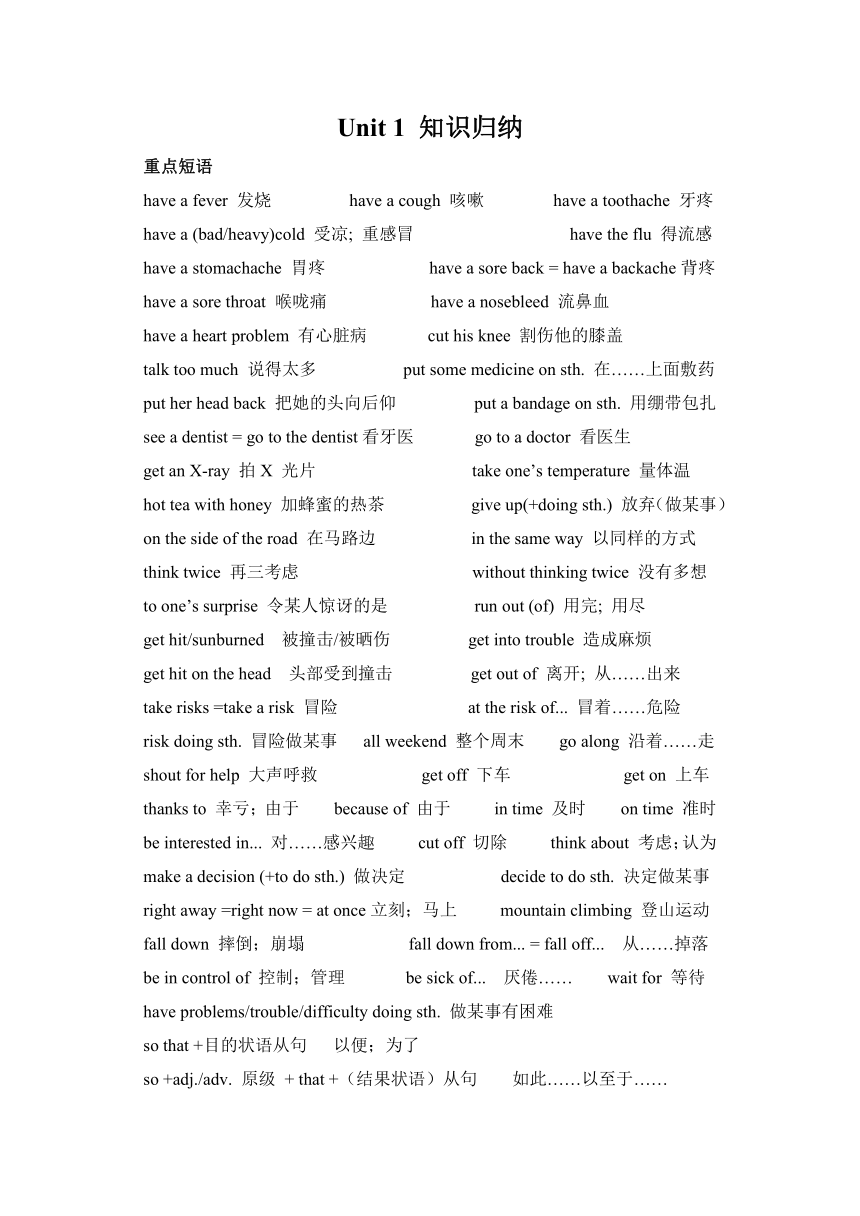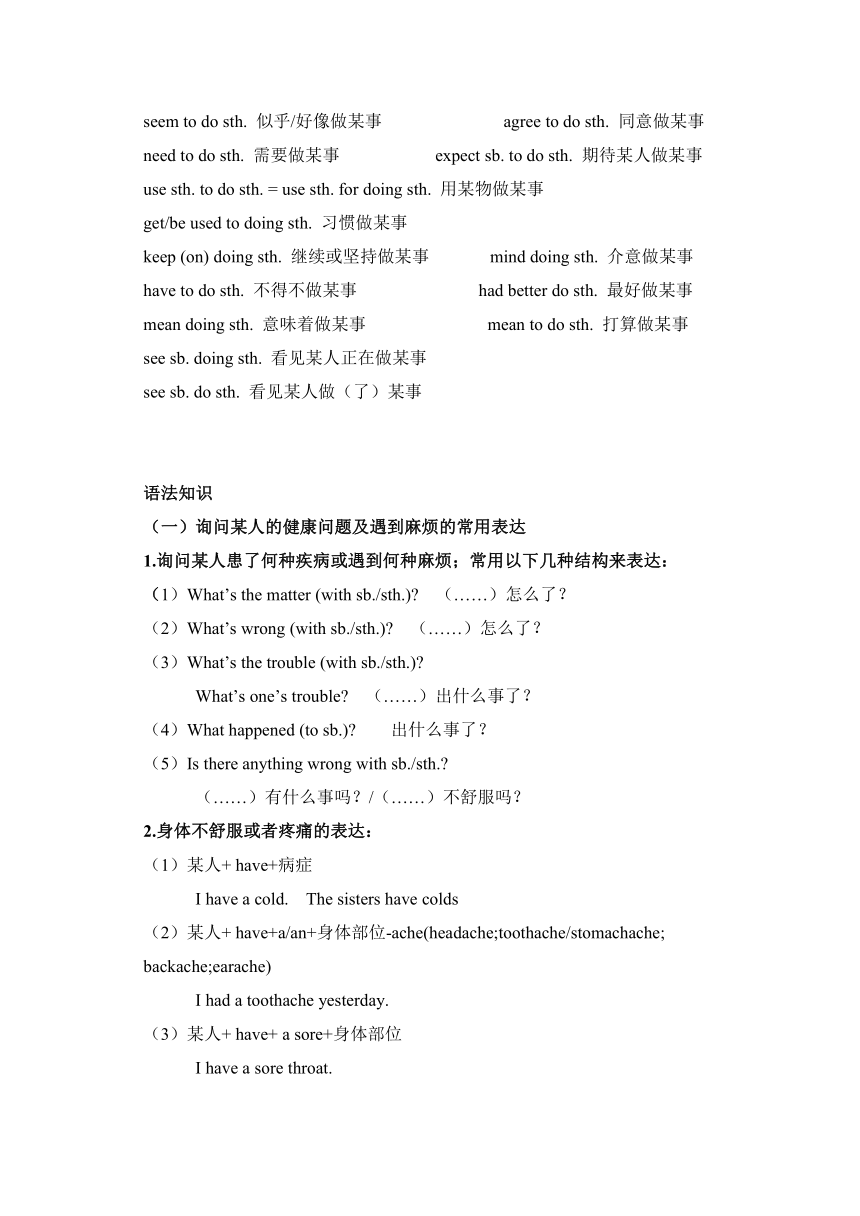Unit 1 What's the matter?知识归纳人教版英语八年级下册
文档属性
| 名称 | Unit 1 What's the matter?知识归纳人教版英语八年级下册 |  | |
| 格式 | docx | ||
| 文件大小 | 22.9KB | ||
| 资源类型 | 教案 | ||
| 版本资源 | 人教新目标(Go for it)版 | ||
| 科目 | 英语 | ||
| 更新时间 | 2024-04-21 21:12:50 | ||
图片预览


文档简介
Unit 1 知识归纳
重点短语
have a fever 发烧 have a cough 咳嗽 have a toothache 牙疼
have a (bad/heavy)cold 受凉; 重感冒 have the flu 得流感
have a stomachache 胃疼 have a sore back = have a backache背疼 have a sore throat 喉咙痛 have a nosebleed 流鼻血
have a heart problem 有心脏病 cut his knee 割伤他的膝盖 talk too much 说得太多 put some medicine on sth. 在……上面敷药
put her head back 把她的头向后仰 put a bandage on sth. 用绷带包扎
see a dentist = go to the dentist看牙医 go to a doctor 看医生
get an X-ray 拍X 光片 take one’s temperature 量体温
hot tea with honey 加蜂蜜的热茶 give up(+doing sth.) 放弃(做某事)
on the side of the road 在马路边 in the same way 以同样的方式
think twice 再三考虑 without thinking twice 没有多想
to one’s surprise 令某人惊讶的是 run out (of) 用完; 用尽 get hit/sunburned 被撞击/被晒伤 get into trouble 造成麻烦
get hit on the head 头部受到撞击 get out of 离开; 从……出来 take risks =take a risk 冒险 at the risk of... 冒着……危险
risk doing sth. 冒险做某事 all weekend 整个周末 go along 沿着……走
shout for help 大声呼救 get off 下车 get on 上车
thanks to 幸亏;由于 because of 由于 in time 及时 on time 准时
be interested in... 对……感兴趣 cut off 切除 think about 考虑;认为
make a decision (+to do sth.) 做决定 decide to do sth. 决定做某事
right away =right now = at once立刻;马上 mountain climbing 登山运动
fall down 摔倒;崩塌 fall down from... = fall off... 从……掉落
be in control of 控制;管理 be sick of... 厌倦…… wait for 等待
have problems/trouble/difficulty doing sth. 做某事有困难
so that +目的状语从句 以便;为了
so +adj./adv. 原级 + that +(结果状语)从句 如此……以至于……
seem to do sth. 似乎/好像做某事 agree to do sth. 同意做某事 need to do sth. 需要做某事 expect sb. to do sth. 期待某人做某事
use sth. to do sth. = use sth. for doing sth. 用某物做某事
get/be used to doing sth. 习惯做某事
keep (on) doing sth. 继续或坚持做某事 mind doing sth. 介意做某事
have to do sth. 不得不做某事 had better do sth. 最好做某事
mean doing sth. 意味着做某事 mean to do sth. 打算做某事
see sb. doing sth. 看见某人正在做某事
see sb. do sth. 看见某人做(了)某事
语法知识
询问某人的健康问题及遇到麻烦的常用表达
1.询问某人患了何种疾病或遇到何种麻烦;常用以下几种结构来表达:
(1)What’s the matter (with sb./sth.) (……)怎么了?
(2)What’s wrong (with sb./sth.) (……)怎么了?
(3)What’s the trouble (with sb./sth.)
What’s one’s trouble (……)出什么事了?
(4)What happened (to sb.) 出什么事了?
(5)Is there anything wrong with sb./sth.
(……)有什么事吗?/(……)不舒服吗?
2.身体不舒服或者疼痛的表达:
(1)某人+ have+病症
I have a cold. The sisters have colds
(2)某人+ have+a/an+身体部位-ache(headache;toothache/stomachache;
backache;earache)
I had a toothache yesterday.
(3)某人+ have+ a sore+身体部位
I have a sore throat.
(4)某人+ hurt/cut/break+身体部位/反身代词
I hurt myself.
She hurts her leg.
身体部位+ hurt
My head hurt.
(There is) something wrong with one’s+身体部位
There is something wrong with my leg.
某人+ have + a pain in one’s +身体部位
I have a pain in my chest.
(8)身体部位+ be killing +me 我的……疼死了。
My foot is killing me.
情态动词should的用法
should情态动词,意为“应该”;其后加动词原形;否定形式是在其后加“not”,缩写为“shouldn’t”。
should的句式结构
句式 结构 例句
肯定句 主语+should +do+其他. We should study hard.
否定句 主语+shouldn’t +do+其他. We shouldn’t play computer games in class.
一般疑问句 Should +主语+do+其他 Yes, 主语+ should. No, 主语+shouldn’t. Should we study hard Yes, you should. No, you shouldn’t.
特殊疑问句 特殊疑问词+should +主语+do+其他 We should study hard. What should you do
用法
用法 例句
1.表示提出建议或意见,“应该” You should drink some water.
2.表示义务、责任,“应该,应当” We should look after our parents.
表示命令、责备、要求,语气比较强烈 You shouldn’t run in the hallway.
表示猜测和可能性,“应该,估计,照理说”(有一定能根据的猜测) He should be a teacher.
表示惊讶、意外、难以置信、不满等情绪,常用语疑问句或感叹句中,“竟然” Why should you do that 你为什么那么做? How should I know 我怎么会知道?
用于主语为第一人称的疑问句中,表示征询意见 Should we tell her about it 我们应该告诉她这件事吗?
反身代词
反身代词(oneself)表示动作反射到动作执行者本身。它还可以在句中起到强调的作用,用以加强语气。 (反射和强调)
第一人称 第二人称 第三人称
单数 myself yourself himself herself itself
复数 ourselves yourselves themselves
反身代词的用法
作宾语
作及物动词和介词的宾语,强调宾语和主语是同一个或物。
We must look after ourselves very well.
I live by myself.
作表语
作系动词后的表语,常用来描述身体或精神状态。
She isn’t quite herself today. 她今天身体不太舒服。
The poor boy was myself. 那个可怜的男孩就是我自己。
作同位语
作主语或宾语的同位语,常用来加强语气。(作主语的同位语放在主语之后或者句末,作宾语的同位语放在宾语之后)
She herself will fly to London tomorrow. 明天她自己将要坐飞机去伦敦。
I met the writer himself last week. 我上周见到了那位作家本人。
用在某些固定短语当中。
teach oneself sth.= learn sth. by oneself 自学
enjoy oneself 玩得高兴,过得愉快
help oneself to sth. 请自用……(随便吃/喝些……)
say to oneself 自言自语
lose oneself in 沉浸于,陶醉于……之中
by oneself 单独,独自
for oneself 亲自,为自己
dress oneself 自己穿衣
重点短语
have a fever 发烧 have a cough 咳嗽 have a toothache 牙疼
have a (bad/heavy)cold 受凉; 重感冒 have the flu 得流感
have a stomachache 胃疼 have a sore back = have a backache背疼 have a sore throat 喉咙痛 have a nosebleed 流鼻血
have a heart problem 有心脏病 cut his knee 割伤他的膝盖 talk too much 说得太多 put some medicine on sth. 在……上面敷药
put her head back 把她的头向后仰 put a bandage on sth. 用绷带包扎
see a dentist = go to the dentist看牙医 go to a doctor 看医生
get an X-ray 拍X 光片 take one’s temperature 量体温
hot tea with honey 加蜂蜜的热茶 give up(+doing sth.) 放弃(做某事)
on the side of the road 在马路边 in the same way 以同样的方式
think twice 再三考虑 without thinking twice 没有多想
to one’s surprise 令某人惊讶的是 run out (of) 用完; 用尽 get hit/sunburned 被撞击/被晒伤 get into trouble 造成麻烦
get hit on the head 头部受到撞击 get out of 离开; 从……出来 take risks =take a risk 冒险 at the risk of... 冒着……危险
risk doing sth. 冒险做某事 all weekend 整个周末 go along 沿着……走
shout for help 大声呼救 get off 下车 get on 上车
thanks to 幸亏;由于 because of 由于 in time 及时 on time 准时
be interested in... 对……感兴趣 cut off 切除 think about 考虑;认为
make a decision (+to do sth.) 做决定 decide to do sth. 决定做某事
right away =right now = at once立刻;马上 mountain climbing 登山运动
fall down 摔倒;崩塌 fall down from... = fall off... 从……掉落
be in control of 控制;管理 be sick of... 厌倦…… wait for 等待
have problems/trouble/difficulty doing sth. 做某事有困难
so that +目的状语从句 以便;为了
so +adj./adv. 原级 + that +(结果状语)从句 如此……以至于……
seem to do sth. 似乎/好像做某事 agree to do sth. 同意做某事 need to do sth. 需要做某事 expect sb. to do sth. 期待某人做某事
use sth. to do sth. = use sth. for doing sth. 用某物做某事
get/be used to doing sth. 习惯做某事
keep (on) doing sth. 继续或坚持做某事 mind doing sth. 介意做某事
have to do sth. 不得不做某事 had better do sth. 最好做某事
mean doing sth. 意味着做某事 mean to do sth. 打算做某事
see sb. doing sth. 看见某人正在做某事
see sb. do sth. 看见某人做(了)某事
语法知识
询问某人的健康问题及遇到麻烦的常用表达
1.询问某人患了何种疾病或遇到何种麻烦;常用以下几种结构来表达:
(1)What’s the matter (with sb./sth.) (……)怎么了?
(2)What’s wrong (with sb./sth.) (……)怎么了?
(3)What’s the trouble (with sb./sth.)
What’s one’s trouble (……)出什么事了?
(4)What happened (to sb.) 出什么事了?
(5)Is there anything wrong with sb./sth.
(……)有什么事吗?/(……)不舒服吗?
2.身体不舒服或者疼痛的表达:
(1)某人+ have+病症
I have a cold. The sisters have colds
(2)某人+ have+a/an+身体部位-ache(headache;toothache/stomachache;
backache;earache)
I had a toothache yesterday.
(3)某人+ have+ a sore+身体部位
I have a sore throat.
(4)某人+ hurt/cut/break+身体部位/反身代词
I hurt myself.
She hurts her leg.
身体部位+ hurt
My head hurt.
(There is) something wrong with one’s+身体部位
There is something wrong with my leg.
某人+ have + a pain in one’s +身体部位
I have a pain in my chest.
(8)身体部位+ be killing +me 我的……疼死了。
My foot is killing me.
情态动词should的用法
should情态动词,意为“应该”;其后加动词原形;否定形式是在其后加“not”,缩写为“shouldn’t”。
should的句式结构
句式 结构 例句
肯定句 主语+should +do+其他. We should study hard.
否定句 主语+shouldn’t +do+其他. We shouldn’t play computer games in class.
一般疑问句 Should +主语+do+其他 Yes, 主语+ should. No, 主语+shouldn’t. Should we study hard Yes, you should. No, you shouldn’t.
特殊疑问句 特殊疑问词+should +主语+do+其他 We should study hard. What should you do
用法
用法 例句
1.表示提出建议或意见,“应该” You should drink some water.
2.表示义务、责任,“应该,应当” We should look after our parents.
表示命令、责备、要求,语气比较强烈 You shouldn’t run in the hallway.
表示猜测和可能性,“应该,估计,照理说”(有一定能根据的猜测) He should be a teacher.
表示惊讶、意外、难以置信、不满等情绪,常用语疑问句或感叹句中,“竟然” Why should you do that 你为什么那么做? How should I know 我怎么会知道?
用于主语为第一人称的疑问句中,表示征询意见 Should we tell her about it 我们应该告诉她这件事吗?
反身代词
反身代词(oneself)表示动作反射到动作执行者本身。它还可以在句中起到强调的作用,用以加强语气。 (反射和强调)
第一人称 第二人称 第三人称
单数 myself yourself himself herself itself
复数 ourselves yourselves themselves
反身代词的用法
作宾语
作及物动词和介词的宾语,强调宾语和主语是同一个或物。
We must look after ourselves very well.
I live by myself.
作表语
作系动词后的表语,常用来描述身体或精神状态。
She isn’t quite herself today. 她今天身体不太舒服。
The poor boy was myself. 那个可怜的男孩就是我自己。
作同位语
作主语或宾语的同位语,常用来加强语气。(作主语的同位语放在主语之后或者句末,作宾语的同位语放在宾语之后)
She herself will fly to London tomorrow. 明天她自己将要坐飞机去伦敦。
I met the writer himself last week. 我上周见到了那位作家本人。
用在某些固定短语当中。
teach oneself sth.= learn sth. by oneself 自学
enjoy oneself 玩得高兴,过得愉快
help oneself to sth. 请自用……(随便吃/喝些……)
say to oneself 自言自语
lose oneself in 沉浸于,陶醉于……之中
by oneself 单独,独自
for oneself 亲自,为自己
dress oneself 自己穿衣
同课章节目录
- Unit 1 What's the matter?
- Section A
- Section B
- Unit 2 I'll help to clean up the city parks.
- Section A
- Section B
- Unit 3 Could you please clean your room?
- Section A
- Section B
- Unit 4 Why don't you talk to your parents?
- Section A
- Section B
- Unit 5 What were you doing when the rainstorm came
- Section A
- Section B
- Review of Units 1-5
- Unit 6 An old man tried to move the mountains.
- Section A
- Section B
- Unit 7 What's the highest mountain in the world?
- Section A
- Section B
- Unit 8 Have you read Treasure Island yet?
- Section A
- Section B
- Unit 9 Have you ever been to a museum?
- Section A
- Section B
- Unit 10 I've had this bike for three years.
- Section A
- Section B
